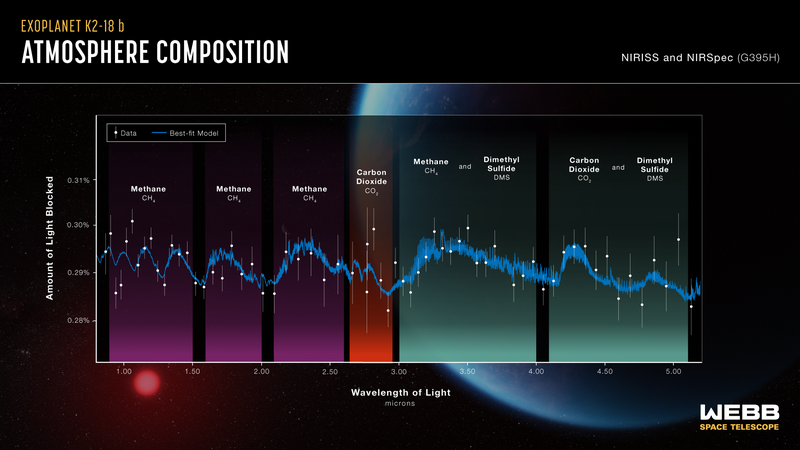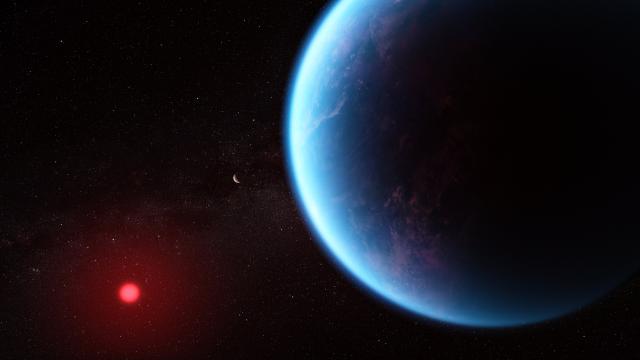The Webb Space Telescope recently turned its focus to a nearby exoplanet and found that it may be a Hycean world, or a world completely covered in a single global ocean, and with a hydrogen atmosphere. And what’s more, the telescope detected a possible detection—note, possible detection, of dimethyl sulphide, a molecule only known to be produced on Earth by living organisms.
The exoplanet is K2-18 b, a world nearly nine times Earth’s size orbiting a star some 120 light-years from Earth. Webb has observed signs of water vapour on exoplanets before, but never an exoplanet that looks to be covered in water oceans.
Webb—launched in December 2021 and taking scientific data of the cosmos since July 2022—did not discover the exoplanet; it was first spotted in 2015 by NASA’s K2 mission.
K2-18 b lies in its star’s habitable zone, meaning the world is at the distance from its star necessary for liquid water to persist on the exoplanet’s surface. Since water is necessary for life as we know it, it is the primary hurdle for exoplanets to meet the our current sensibilities as to what’s meant by habitable. Another hurdle is the exoplanet’s temperature; it’s possible that K2-18 b is too hot for any of its oceans to sustain life, or even be liquid, according to a NASA release.
In its benchmark decadal survey on astronomy and astrophysics, the National Academies of Sciences, Engineering, and Medicine stressed the importance of finding habitable worlds. Webb is a crucial part of that search and NASA has already drawn up plans for the still-juvenile Webb’s successor in that search, the Habitable Worlds Observatory. But that mission won’t launch for at least a decade, leaving Webb (and the Hubble Space Telescope, Webb’s still-operational predecessor) to do plenty of exoplanetary legwork.
Hubble observed the recently observed exoplanet back in 2019 and found signs that the planet’s atmosphere contained water vapour. The Webb observations go a step further. The telescope’s Near-Infrared Imager and Slitless Spectrograph (NIRISS) and Near-Infrared Spectrograph (NIRSpec) instruments took spectra of K2-18 b, by seeing how much starlight was impeded in the exoplanet’s atmosphere as it passed in front of its star.

Webb discerned the presence of carbon-bearing molecules like methane and carbon dioxide, but little ammonia, on the planet. That chemical composition suggests that K2-18 b may contain a water ocean beneath its hydrogen atmosphere. Analysis of the candidate Hycean world is hosted on the preprint server arXiv and is accepted for publication in The Astrophysical Journal Letters.
“Our findings underscore the importance of considering diverse habitable environments in the search for life elsewhere,” said Nikku Madhusudhan, an astronomer at the University of Cambridge and the study’s lead author, in the NASA release. “Traditionally, the search for life on exoplanets has focused primarily on smaller rocky planets, but the larger Hycean worlds are significantly more conducive to atmospheric observations.”
Webb also detected what looked like dimethyl sulphide (DMS) in the planet’s atmosphere. On Earth, dimethyl sulphide is produced by living things, and most of our planet’s atmospheric DMS is produced by marine phytoplankton. “Upcoming Webb observations should be able to confirm if DMS is indeed present in the atmosphere of K2-18 b at significant levels,” Madhusudhan added.
Madhusudhan added that the data collected by Webb in just two observations of K2-18 b are equivalent to eight observations done with Hubble, thanks to the newer space observatory’s sensitivity and the range of wavelengths at which it observes.
Follow-up observations of the Hycean candidate will be conducted using Webb’s Mid-Infrared Instrument, or MIRI. While the detection of dimethyl sulphide is very tentative, K2-18 b is increasingly showing signs it is a water world with potential—if not for astrobiological reasons, for better understanding the types of habitable worlds in our nearby universe.
